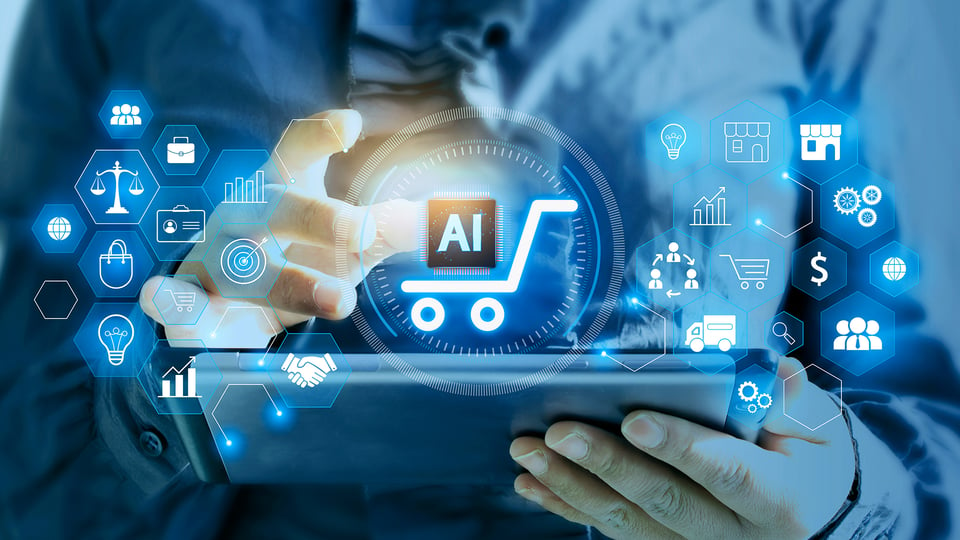Artificial intelligence is transforming ecommerce by personalizing experiences, enhancing customer service, and optimizing operations. But the pace of change is accelerating - new AI partnerships and tools are emerging every month, redefining how brands connect with consumers.
This is a living guide to how AI is redefining ecommerce in real time. We’ll keep updating it with new innovations and examples from brands like OpenAI, Amazon, and Walmart as they push the boundaries of what’s possible in digital retail.
AI market pulse - Latest developments
Below are some of the latest innovations shaping how AI and ecommerce intersect - from conversational shopping to creative automation.
21 Oct 2025 - Walmart exec confirms: 3P marketplace products coming to ChatGPT
Walmart has confirmed that its upcoming ChatGPT Instant Checkout integration will include third-party marketplace products, expanding available SKUs by more than sixfold to nearly 500 million items. This update positions ChatGPT as one of the world’s largest digital storefronts, with new data from Euromonitor International ranking it as the #2 ecommerce site by daily traffic, second only to Amazon.
Together, these developments signal that agentic commerce is moving from concept to reality, with AI becoming not just a shopping assistant, but a fully transactional platform driving real sales at scale.
14 Oct 2025 - Walmart partners with OpenAI for AI-first shopping
Walmart and Sam’s Club have announced a groundbreaking partnership with OpenAI to enable AI-first shopping experiences directly inside ChatGPT. Through Instant Checkout, customers can soon complete purchases from Walmart without ever leaving the chat interface.
This new approach marks a shift toward agentic commerce, where AI moves from reactive responses to proactive engagement - learning, predicting, and helping customers anticipate their needs before they do.
As Walmart integrates ChatGPT Enterprise and OpenAI Certifications across its workforce, the collaboration highlights how major retailers are preparing for a future where AI becomes the shopping interface itself.
29 Sept 2025 - ChatGPT adds instant checkout and enters agentic commerce
OpenAI has launched Instant Checkout in ChatGPT - letting people discover and buy products directly in the chat without leaving the app.
Starting in the U.S., users can now shop from Etsy sellers, with Shopify brands like Glossier, SKIMS, Spanx, and Vuori coming soon. It’s the first step toward what’s called agentic commerce — where AI doesn’t just recommend products, it actually helps you complete the purchase.
To power this, OpenAI worked with Stripe to create a new system that connects AI, shoppers, and businesses in a secure way while still letting merchants handle their own payments, orders, and customer service.
👉 Learn more: How to compete in the age of Agentic Commerce
17 Sept 2025 - Amazon ads launches agentic AI creative partner
Amazon Ads has unveiled a new agentic AI tool in Creative Studio that acts as a conversational creative partner for advertisers. By chatting with the tool, brands can brainstorm campaign ideas, generate video and display ads, and produce polished assets within hours.
The system uses Amazon’s retail insights to understand products, audiences, and brand tone, ensuring every creative aligns with real shopper intent. What once required large budgets and creative agencies can now be done in-house, instantly.
This shift democratizes advertising, empowering smaller sellers to produce high-quality, data-driven ads at scale, signaling a broader move toward AI-automated retail media.
Other emerging trends
1. Rise of agentic AI in commerce
AI systems are quickly evolving from passive assistants that simply respond to prompts into autonomous agents capable of understanding intent, planning tasks, and taking action on behalf of both customers and sellers. These agentic systems can predict what shoppers need, curate personalized recommendations, manage reorders, or even negotiate delivery preferences automatically.
For retailers, this shift means that shopping journeys are becoming more dynamic and predictive - where AI not only reacts but actively shapes customer decisions and logistics behind the scenes. It’s the foundation of a new era of agentic commerce, where conversational and transactional experiences merge seamlessly.
2. Cross-platform AI shopping experiences
With platforms like ChatGPT, Gemini, and Alexa now gaining direct checkout capabilities, shopping is no longer limited to websites or apps. Consumers can research, compare, and buy products across multiple AI platforms through natural conversations, voice commands, or image-based searches.
This development is blurring the line between discovery and conversion, giving rise to an ecosystem where every digital interaction can become a shopping moment. Retailers that prepare their product data for these multimodal, cross-platform environments will stand out - ensuring their products are visible and purchasable wherever customers engage.
Read more: AI-powered shopping and the future of the fashion industry
3. AI-driven product data optimization is the new product SEO
As AI becomes the engine behind product discovery, the traditional rules of search optimization are being rewritten. Large language models and recommendation algorithms now determine which items appear first in shopping chats and AI-generated results.
To stay competitive, brands must treat product data optimization like the new form of SEO — ensuring that titles, attributes, and descriptions are structured, detailed, and contextually rich. Clean, accurate, and enriched product data will increasingly decide whether your products are surfaced by AI or left unseen.
See how brands can future-proof their product listings here - AI-Powered Product Discovery: How Social and GenAI search are reshaping the marketplace funnel
While these trends are shaping the next generation of commerce, the foundation of AI in ecommerce still lies in its day-to-day applications that help sellers operate more efficiently and profitably.
AI in ecommerce marketplace management
From a seller's perspective, AI isn’t just a tool for personalization but a game-changer for operational efficiency and customer engagement. By utilizing AI-driven tools, marketplace sellers can optimize inventory management, enhance customer service through chatbots, and gain actionable insights from data analytics.
In this section, we’ll look at both established AI capabilities that drive success today and the emerging innovations shaping the next phase of digital commerce.
1. Purchase recommendations
Algorithms powered by AI in ecommerce analyze user behavior and historical data to provide customized product recommendations. These recommendations improve the user experience and increase the chances of conversions. By recognizing a shopper's preferences, AI can curate a selection of products that match their tastes, resulting in increased customer satisfaction and engagement.
Amazon is the most well-known ecommerce marketplace for product recommendations. In fact, according to some reports, 44% of purchases via Amazon come from AI recommendations. These recommendations also increase brand loyalty for millennials by 28%.
2. Visual search from images (Pinterest)
Visual search takes shopping to a new level. Platforms like Pinterest employ AI in ecommerce to enable users to search for products based on images. This innovative ecommerce technology allows shoppers to snap a photo or upload a picture, and the AI system finds similar products available for purchase. This seamless integration of AI and visual search enhances the discovery of unique items, making the shopping journey more intuitive and enjoyable.
3. AI-Powered product bundle creation
Product bundling is a strategic marketing approach that encourages customers to purchase complementary items. AI-driven algorithms analyze customer preferences and buying patterns to suggest ideal product bundles. This increases sales and enhances cross-selling opportunities, allowing retailers to cater to diverse consumer needs.
AI can generate unique product titles and descriptions with the assistance of large language models, allowing you to save time and add a creative touch to your messaging. This can be reflected across all marketplaces you operate on, making it an excellent sales-boosting tool.
Amazon, Shopify, and Rakuten use AI-driven algorithms to optimize product bundling creation.
4. AI-powered advertising (Google Ads)
AI in ecommerce is revolutionizing advertising campaigns by optimizing targeting and delivery. In Google Ads, AI algorithms analyze vast amounts of data to determine the most effective keywords, ad placements, and bidding strategies. This results in improved ad performance, higher click-through rates, and a better return on investment for ecommerce businesses.
Image Source - Secret Escapes Google Ads Smart Bidding Performance
Secret Escapes, a British travel company that sells drastically discounted luxury travel packages, deployed machine learning to optimize its Google Ads, enhance its bidding setup, and lower its Cost Per Lead (CPL). Secret Escapes reduced its CPL by 38% and increased its ad click-through rate by 23% by utilizing Google Ads campaign models, experiments, and Smart Bidding.
5. Chatbots and virtual assistants
AI-powered chatbots and virtual assistants provide real-time support to online shoppers. 61% of US consumers say they are more inclined to purchase from a brand if they can message them.
These intelligent agents can answer customer queries, provide product information, and even assist in the purchasing process. AI-driven chatbots improve customer satisfaction and reduce cart abandonment rates by offering instant, personalized assistance.
Lego, one of the world's most successful toy companies, was the first toy retailer to implement an ecommerce chatbot for customers.
In 2017, Ralph the chatbot was introduced to support holiday sales and was an instant hit.
Utilizing Facebook Messenger generated 25% of all social media sales and reduced the cost per conversion by 71%.
Unsurprisingly, Lego chose to extend the use of its ecommerce chatbot: Ralph now directs customers year-round through Lego's vast catalog.
Evolving frontiers in AI commerce
1. Dynamic pricing becomes smarter:
Dynamic pricing is now a standard strategy across ecommerce, but AI is making it smarter and more predictive than ever - enabling brands to anticipate market changes rather than just react to them.
Utilizing big data analytics and AI in ecommerce firms can determine optimal price points that customers are willing to pay, adapting to daily market conditions. This flexibility enables prompt responses to changes in demand, maximizing profits and maintaining a strong market presence. Unlike fixed pricing, dynamic pricing allows organizations to adjust prices based on real-time customer behavior and market trends.
The ecommerce industry is very reliant on data-driven decision-making, and brands in this domain can benefit most from this approach. Sophisticated algorithms and AI enable companies to tailor prices to individual customers or specific product categories, enhancing revenue potential and staying ahead of the competition. ChannelEngine's dynamic repricer simplifies this process, offering an efficient solution for businesses.
Brands and retailers that use our dynamic pricing feature are able to stay agile and responsive to market changes, whether due to a surge in demand or competitor price cuts, enabling immediate action to maximize earnings - especially when it comes to winning the buy box.
2. Immersive augmented reality (AR) shopping:
The online shopping experience continues to evolve thanks to augmented reality (AR). Customers can see products in their environment before purchasing with AR, which superimposes digital features on the actual world. AR improves customer confidence and lowers the possibility of post-purchase dissatisfaction by allowing users to put on virtual clothes and arrange furnishings in a room.
The upscale brand Valentino collaborated with Wanna, an augmented reality startup owned by Farfetch. Customers can try on handpicked items from the Valentino Urban Flows Fall 2023 men's collection using the Wanna Wear smartphone app, sampling virtual clothing in real-time, and sharing looks with friends.
3. Automated inventory management:
Using AI in ecommerce, algorithms learn to identify products likely to sell well based on historical sales data, which is the first step toward automating inventory management. This can be accomplished by analyzing previous purchases or by employing predictive analytics tools such as Google's Cloud Machine Learning Engine (MLE).
Once you know what customers have purchased in the past, you can use this information to determine which items should be kept in stock at all times and how many units must be replenished when they run out.
Fellow AI provides real-time inventory management using image recognition. NAVii, one of its robot editions, can move up and down building aisles to see what items are present and is outfitted with data-collecting cameras.
Image Source: Lowes Innovation Labs
Lowe's, a chain of home improvement stores, utilizes Fellow robots called "LoweBots" in some locations to assist customers and keep an eye on inventories.
In ecommerce, based on data from orders and returns, H&M utilizes predictive AI to decide which products to recommend to customers. The brand receives information from the AI system about which products to supply in each market and which should be marketed based on popular products.
Walmart employs AI to improve their ecommerce operations including daily supply chain workflows and forecast demand cycles, particularly during high or unforeseen customer activity. Finding solutions has taken years of work in data curation, data collection, adaptable algorithm development, and a worldwide, not piecemeal, technology strategy.
ChannelEngine offers a very efficient solution for cloud-based inventory management.
4. AI + IoT = Seamless commerce:
The Internet of Things (IoT) is about interconnected devices sharing data. AI in ecommerce can harness this data to offer personalized shopping suggestions. For example, a smart refrigerator could detect when a household is running low on specific items and automatically add them to an online shopping cart. This level of integration creates a seamless shopping experience tailored to individual needs.
IoT can also help merchants better under the logistics process by tracking items throughout the supply chain. Access to data like traffic conditions, weather, location, and personnel IDs (Radio-Frequency Identification) can be made possible via cloud-based technologies like GPS and RFID. Such data can help to optimize shipping and order fulfillment.
5. Rebuilding customer trust:
As AI chatbots are increasingly deployed, customers often feel companies prioritize efficiency over human engagement, eroding trust. To rebuild this trust, businesses must use AI ethically and be transparent.
Companies should disclose when and how AI is used and explain its decisions. This transparency helps demystify AI and build trust and reliability. Honest interaction is essential for trust.
By being open about AI's role and respecting customer preferences for human contact, businesses can create a balanced, trustworthy relationship. Ethical AI usage combined with a commitment to transparency forms a basis for customers to trust businesses as AI becomes more prevalent.
6. Improved voice search:
Voice search technology has revolutionized the way we find information, allowing us to simply speak our queries instead of typing them out. This innovation relies on automatic speech recognition (ASR) software, which turns our spoken words into text. The ASR software then processes and analyzes this text, scouring a database for matching results. These results are then neatly presented to us, often in the form of a list.
The beauty of voice search lies in its versatility. Whether you need directions, weather updates, sports scores, factual information, or even product details, voice search has got you covered. It brings a natural, conversational feel to our interactions with technology, making it much more intuitive and user-friendly.
What distinguishes voice search from traditional text-based searches is its conversational style. Instead of typing keywords, we speak in full sentences, similar to chatting with a friend. For example, while someone typing "best Italian restaurants" might be looking for general recommendations, a voice search like "What are the top Italian restaurants near me?" is more specific and context-rich. This kind of query taps into location-based services like Google Maps, delivering tailored results that are highly relevant to the user's immediate needs.
This shift means that search engines need to be smarter and understand context, intent, and user behavior more deeply.
Final Thoughts
AI is no longer a future trend in ecommerce - it’s the core driver of how modern retail operates and grows. From personalized recommendations to automated fulfillment and creative ad generation, AI is redefining how shoppers discover, decide, and buy.
As the pace of innovation accelerates, staying ahead means more than adopting new tools - it’s about understanding how technologies like agentic AI, cross-platform shopping, and AI-powered product data will continuously reshape the way brands compete. For ecommerce businesses, this is both a challenge and an opportunity: those who adapt early will shape the customer journeys of tomorrow.
At ChannelEngine, we help brands stay ready for this new era of intelligent commerce - connecting products, data, and marketplaces so they remain visible, agile, and competitive in an increasingly AI-driven ecosystem.
Schedule a call with one of our experts today!




